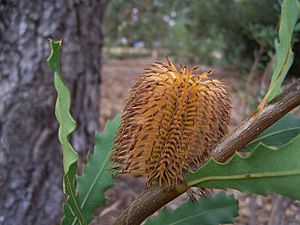Banksia ser. Quercinae facts for kids
Quick facts for kids Banksia ser. Quercinae |
|
|---|---|
 |
|
| B. quercifolia (Oak-leaved Banksia), the type species of B. ser. Quercinae. | |
| Scientific classification | |
| Kingdom: | |
| (unranked): | |
| (unranked): | |
| Order: | |
| Family: | |
| Genus: | |
| Series: |
B. ser. Quercinae
Meisn.
|
Banksia ser. Quercinae is a special group, or series, of plants within the larger Banksia genus. A botanic name is a scientific name given to plants. This series was first described by a scientist named Carl Meissner in 1856. Since then, its definition has changed a few times as scientists learned more about these plants.
Contents
How Meissner Saw It
In 1856, Carl Meissner wrote about the Banksia plants in a big book. He divided a group called Eubanksia into four smaller series. B. ser. Quercinae was one of them.
Meissner grouped plants into this series based on their leaves. He included species with leaves that were strongly toothed and shaped like a wedge or an upside-down egg. However, because he only looked at leaves, his groups often contained very different plants.
Here's a simplified look at how Meissner organized some Banksia plants:
- Banksia
- B. sect. Eubanksia
- B. ser. Quercinae
- B. coccinea
- B. sceptrum
- B. Baueri
- B. ornata
- B. robur (known as B. latifolia back then)
- B. praemorsa (known as B. marcescens back then)
- B. oblongifolia
- B. serrata
- B. aemula
- B. Caleyi
- B. Lemanniana
- B. quercifolia
- B. dentata
- B. gardneri (known as B. prostrata back then)
- B. Goodii
- B. barbigera
- B. repens
- B. Solandri
- B. ser. Quercinae
- B. sect. Eubanksia
Meissner's way of grouping plants was used until 1870. Then, another scientist, George Bentham, created his own system and didn't use Meissner's series.
How Alex George Saw It
In 1981, a scientist named Alex George did a big study of Banksia plants. He brought back the name B. ser. Quercinae. He placed it within a group called B. sect. Banksia.
George defined this series by looking at the flowers and fruits. He included species with special flower parts called perianths that had a pointed tip, and fruits called follicles that had a beak-like shape. At first, this series had three species. But in 1988, George moved B. baueri (Woolly Orange Banksia) into its own series. This left only two species in B. ser. Quercinae: B. quercifolia (Oak-leaved Banksia) and B. oreophila (Western Mountain Banksia).
Here's a simplified look at George's organization for this group:
- Banksia
- B. subg. Banksia
- B. sect. Banksia
- B. ser. Quercinae
- B. sect. Banksia
- B. subg. Banksia
How Thiele and Ladiges Saw It
In 1996, two scientists, Kevin Thiele and Pauline Ladiges, studied the physical features (morphology) of Banksia plants. They used a method called cladistics to figure out how the plants were related. This created a family tree (phylogeny) that was a bit different from George's.
They found that B. ser. Quercinae was a monophyletic group. This means all its members came from a single common ancestor. They kept the series and placed it close to another group called B. ser. Spicigerae.
Here's a simplified look at Thiele and Ladiges' organization for this group:
- Banksia
- B. subg. Banksia
- B. ser. Quercinae
- B. subg. Banksia
Thiele and Ladiges' system was used until 1999. Then, Alex George published an updated version of his 1981 system. His new system considered some of Thiele and Ladiges' findings, but he mostly stuck to his original ideas. For B. ser. Quercinae, George's 1999 system was the same as his 1988 one.
New Discoveries
Since 1998, a scientist named Austin Mast has been studying the DNA of Banksia plants. His studies show a family tree that is very different from Alex George's system. For example, he found that Banksia might not be a single group (it could be paraphyletic) if you don't include another plant group called Dryandra.
However, when it comes to B. ser. Quercinae, Mast's DNA studies agree with the earlier systems. They show that its two species form their own distinct group, separate from other Banksia plants.
In 2007, Mast and Thiele started to rearrange the Banksia genus. They moved Dryandra into Banksia. They also created a new subgroup called B. subg. Spathulatae for species with spoon-shaped cotyledons (the first leaves that appear when a seed sprouts). The plants in B. ser. Quercinae belong to this new subgroup. Mast and Thiele plan to publish a complete new arrangement once they finish studying the DNA of all Dryandra species.
See also
 In Spanish: Banksia ser. Quercinae para niños
In Spanish: Banksia ser. Quercinae para niños

